

The End Of Apps, Why People Leave Companies, AirBNB's Culture, Vine's Design Secrets, The One Metric That Matters, Value Proposition Design. The End Of Apps As We Know Them. The experience of our primary mobile screen being a bank of app icons that lead to independent destinations is dying.
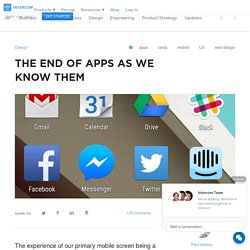
And that changes what we need to design and build. How we experience content via connected devices – laptops, phones, tablets, wearables – is undergoing a dramatic change. The idea of an app as an independent destination is becoming less important, and the idea of an app as a publishing tool, with related notifications that contain content and actions, is becoming more important. This will change what we design, and change our product strategy. No more screens full of app icons This is such a paradigm shift it requires plenty of explaining. The idea of having a screen full of icons, representing independent apps, that need to be opened to experience them, is making less and less sense. The primary design pattern here is cards. Designing systems not destinations I covered this topic in detail in a previous post, so I’ll quickly summarise here.
But that is changing fast. This is Why People Leave Your Company. The Business Model Canvas Gets Even Better – Value Proposition Design. Product/Market fit now has its own book.
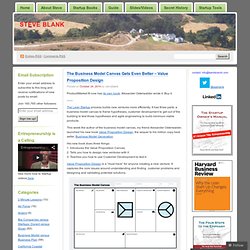
Alexander Osterwalder wrote it. Buy it. The Lean Startup process builds new ventures more efficiently. It has three parts: a business model canvas to frame hypotheses, customer development to get out of the building to test those hypotheses and agile engineering to build minimum viable products. This week the author of the business model canvas, my friend Alexander Osterwalder, launched his new book Value Proposition Design, the sequel to his million copy best seller, Business Model Generation. His new book does three things: 1. Value Proposition Design is a “must have” for anyone creating a new venture. Product/Market fit Product/Market FitIf you’re familiar with the Lean Startup you know that the Business Model Canvas is the tool to frame all the hypotheses of your startup. Integration with Customer Development and Lean Startup Alexander and I met after he published Business Model Generation.
Lessons Learned. Don’t Fuck Up the Culture. Hey team, Our next team meeting is dedicated to Core Values, which are essential to building our culture.
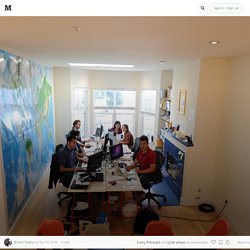
It occurred to me that before this meeting, I should write you a short letter on why culture is so important to Joe, Nate, and me. After we closed our Series C with Peter Thiel in 2012, we invited him to our office. This was late last year, and we were in the Berlin room showing him various metrics. Midway through the conversation, I asked him what was the single most important piece of advice he had for us. He replied, “Don’t fuck up the culture.” This wasn’t what we were expecting from someone who just gave us $150M. Were we destined to eventually “fuck up our culture?” Culture is simply a shared way of doing something with passion. Our culture is the foundation for our company. The thing that will endure for 100 years, the way it has for most 100 year companies, is the culture. So how do we build culture? By upholding our core values in everything we do.
Blog – Design at Vine: Everyone needs an editor. We launched Vine about two weeks ago, and we’re already amazed at how a community of creators is using the new art form.
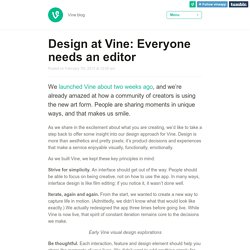
People are sharing moments in unique ways, and that makes us smile. As we share in the excitement about what you are creating, we’d like to take a step back to offer some insight into our design approach for Vine. Design is more than aesthetics and pretty pixels; it’s product decisions and experiences that make a service enjoyable visually, functionally, emotionally. As we built Vine, we kept these key principles in mind: Strive for simplicity. Iterate, again and again. Early Vine visual design explorations Be thoughtful. Early main navigation design explorations We think these principles hold across the service, from the number of menu options to the prevalence of smiley faces throughout the mobile app (more on that in a future post). The only metric that matters. I've been lucky to be part of the early growth of several really interesting and now important networks including LinkedIn, Facebook, and Twitter.
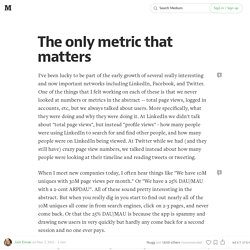
One of the things that I felt working on each of these is that we never looked at numbers or metrics in the abstract -- total page views, logged in accounts, etc, but we always talked about users. More specifically, what they were doing and why they were doing it. At LinkedIn we didn't talk about "total page views", but instead "profile views" - how many people were using LinkedIn to search for and find other people, and how many people were on LinkedIn being viewed. At Twitter while we had (and they still have) crazy page view numbers, we talked instead about how many people were looking at their timeline and reading tweets or tweeting.
When I meet new companies today, I often hear things like "We have 10M uniques with 30M page views per month. " How many people are really using your product? You need a metric that specifically answers this.